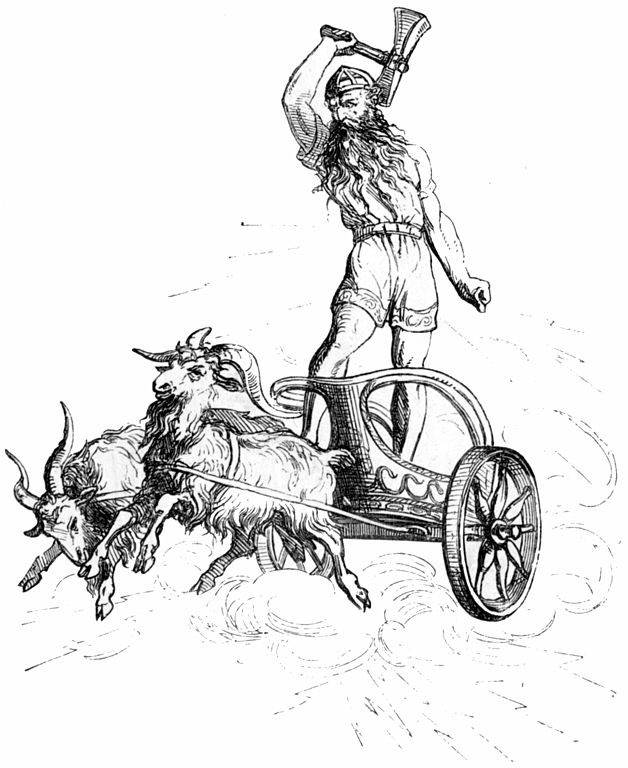Tanngrisnir and Tanngnjóstr were two goats who pulled the mighty Thor’s chariot through the skies of the nine realms. Thor and Mjolnir had the power to resurrect them from the dead, which was necessary since Thor chose to kill and eat them for dinner on at least one occasion!
Who were Tanngrisnir and Tanngnjóstr in Norse mythology?
Goats appear on several occasions in Norse mythology. Heiðrún produces the never-ending supply of mead to the einherjar in Valhalla after eating leaves from the tree Læraðr (probably a different name for Yggdrasil).
Loki engages in a strange tug-of-war with a goat to appease the giant Skadi, who is seeking retribution after Odin had her father killed.
Thor had plenty of ways to move around the nine realms. Mjölnir had the power to send him airborne if he held onto it. He could travel between Asgard and Midgard (home of the humans) by using the Bifrost, and he could rely on his magical pair of goats to whisk him away whenever and wherever he desired.
Tanngrisnir and Tanngnjóstr: Name Etymology
The Old Norse name Tanngrisnir means “teeth-barer or “snarler,” while Tanngnjóstr translates to “teeth-grinder” or “tooth-gnasher.”
Scholar Rudolf Simek observes that the terms may have been the inventions of the Islandic politician, historian, and poet Snorri Sturluson. Tanngiost is a modern anlglicization of Tanngnjóstr.
For what were Thor’s goats used?
Although the extraordinary powers of his hammer, Mjölnir, could pull the god of thunder through the air, whenever he undertook a long journey or wanted to transport goods or companions, he would choose his trusty goats and chariot.
Thor could resurrect Tanngrisnir and Tanngnjóstr by using Mjölnir to transform their hide and bones into living creatures again. In this way, Thor could use the goats as a food source in cases of emergency.

Tanngrisnir and Tanngnjóstr’s Story in the Poetic and prose Edda
The goats are attested in the 13th-century Codex Regius or Poetic Edda and Sturluson’s Prose Edda, written in the same period.
Poetic Edda
A poem called Hymiskviða in the Poetic Edda mentions Thor’s goats, although it does not name them. A man called Egil from Midgard helps catch the goats before Thor and Tyr (the Norse god of war) continue their journey to the hall of Hymir, the jötunn. The goats go lame due to their exertions fighting Hymir’s army. Thor is also referred to in a later stanza as “the lord of the goats.”
A passage from the well-known poem Þrymskviða tells how Thor journeyed to Jotunheim on his goat-driven chariot.
Prose Edda
The Prose Edda attestations occur during the account of Thor and Loki’s epic journey to Jotunheim and are very similar to the ones in the Poetic Edda.
Early in their travels, while passing through Midgard, they decided to stop at a farm for the night. Egil, the farmer, was extremely poor, and he and his family could only offer a few vegetables for the travelers to eat. Thor is often described as a man with a vast appetite who could eat a whole ox in one sitting.
Because Thor knew he could resurrect Tanngrisnir and Tanngnjóstr, he decided to kill and cook them to provide enough food for everyone. However, before serving the meal, he stipulated they must not break the bones and only eat the meat off them. When they had finished with them, they were to lay them on one of the goat skins he had spread on the farmhouse floor.
Thor had one goat to himself, laying the bones onto one of the skins. The other five shared the second, setting those bones onto the second skin. However, unbeknown to Thor, Loki had beguiled the farmer’s son Thjalfi with tales of how sweet the marrow within the bones tasted, and the boy consequently broke one of the leg bones in half to try it. He then put the bone at the bottom of the pile so Thor would not see it.
Resurrection Ritual
Early the following day, Thor took the two goatskins outside and began his resurrection ritual, swinging Mjölnir over the skins and bones.
The bones began to take the shape of the two goats, the skins then wrapped themselves around each skeleton, and eventually, the goats were whole again and alive. However, Thor noticed that Tanngnjóstr was lame and realized what had happened after feeling the broken bone in its leg.
He flew into a thunderous rage and demanded to know who had broken one of the bones when he had explicitly told the family not to. Thjalfi admitted to Thor that he was responsible, and Thor gradually calmed down, especially when he noticed how terrified the farmer and his family were.
To appease Thor’s anger, the farmer offered Thjalfi and his daughter Roskva to Thor as servants. Thor accepted after hearing that Thjalfi was a magically fast runner, and they accompanied the pair on the next stage of their journey to the land of the giants.
Egil and his wife were left to tend the goats and aid Tanngnjóstr in his recovery until Thor, and his companions returned.
Thor’s goats in Marvel movies
The latest installment of the MCU Thor series, “Thor Love and Thunder” (directed by Taika Waititi, who also reprises his role as Korg), is the first of the franchise to feature any goats.
Thor’s goats nearly found their way into the first Thor movie, but the Marvel Universe management team did not like the idea and rejected it. However, after becoming more open to experimentation after the success of the first three movies, they decided to include the goats in the fourth one.
The movie tells how Thor and his fellow Guardians of the Galaxy save the plant Indigarr from an invasion of nasty “Angry Bird”-like creatures, and their king Yakan gives Thor a pair of goats in gratitude.
These screaming goats were one of the hit aspects of the film. According to Taika Waititi, a fan-made meme of the Taylor Swift song “Trouble” inspired the technician to use the screaming from the meme when dubbing the sound onto the CGI goats.
In the film, Thor (Chris Hemsworth) battles Gorr (Christian Bale), the god killer, in his quest for supreme universal power. The Asgardian’s allies, including King Valkyrie (Tessa Thompson), Doctor Jane Foster (Natalie Portman), and Korg (director Taika Waititi), help him through adventures in New Asgard, Omnipotence City, and Eternity.
Thor’s goats have also appeared in some Marvel Comics publications; for example, “Toothgnasher” and “Toothgrinder” (as they are called) appear in the comic book Thor Annual #5.

